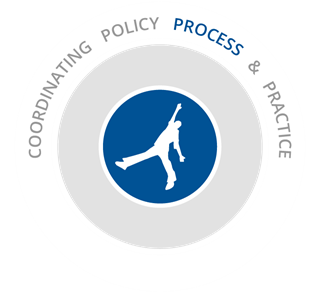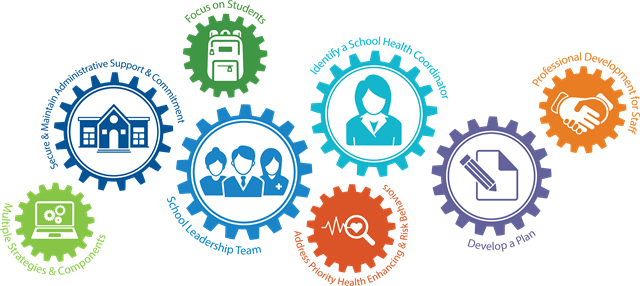- Educator Resources>
- WSCC>
- Process
 Process
Process
Our Process
We utilize an eight step process to assist with WSCC implementation which was adapted from the CDC’s guidelines for implementing CSH.

 Secure and maintain administration support
Secure and maintain administration support
Leaders provide support by incorporating health in the school's or organizational vision and mission statements; appointing someone to oversee school health; allocating resources; and communicating the importance of wellness to students, school staff, and parents.
Lessons learned:
- It is helpful to outline a plan during a slower point in the year.
- Administrative support is critical to successful initiatives.
- It is important to find common goals.
- Quick conversations are important in this effort.
 Establish school leadership team
Establish school leadership team
These teams should include school administrators, parents, students, and community representatives involved in the health and well-being of students. School leadership teams should include a site administrator, an identified school health coordinator, and teachers.
Lessons learned:
- Identify a consistent meeting date, time, and location.
- Develop a communication plan to reach out to team members.
- Distribute tasks in an effective manner.
- Be sure to follow-up.
 Identify a school health coordinator
Identify a school health coordinator
The school health coordinator (SHC) helps maintain active school health councils, facilitates health programming, organizes activities addressing the WSCC components, and facilitates actions to achieve a successful, coordinated school health system (e.g., policies, programs, activities, and resources).
Lessons learned:
- Have an application process in place for the SHC role.
- Plan and schedule training and planning time for SHC.
- Focus on integration for school health teams.
- Time is a barrier.
 Develop a plan
Develop a plan
The plan should present a strategy for achieving health promotion goals and fit into a school's overall improvement plan to link health with learning outcomes.
Lessons learned:
- Broaden the scope of the action to show the work of all school based teams.
- Work to ensure the plan is sustainable.
- School health teams should be involved in plan development.
- Distribute responsibilities evenly.
 Implement multiple strategies and multiple components
Implement multiple strategies and multiple components
Each WSCC component employs a unique set of strategies. Coordination is necessary so every strategy can be used to address health behaviors and improve student learning.
Lessons learned:
- People can be protective of their area.
- Many people are working on similar initiatives.
- Building relationships and trust is important.
 Focus on students
Focus on students
The focus of the WSCC model is meeting the education and health needs of students, and providing opportunities for students to be meaningfully involved in the school and the community.
Lessons learned:
- Students must be part of the whole process
 Address priorities
Address priorities
Schools can implement policies and programs to help students avoid or reduce health-risk behaviors that contribute to the leading causes of death and disability among young people as well as among adults.
Lessons learned:
- Develop strategies to address identified issues.
- Use a consistent measurement tool.
- Incorporate quantitative and qualitative data.
 Professional development for staff
Professional development for staff
Professional development provides opportunities for school employees to identify areas for improvement, learn about and use proven practices, solve problems, develop skills, and reflect on and practice new strategies.
Lessons learned:
- Whole school engagement is important.
- Application of the process is a challenge.
If you have any questions about the WSCC model and how it is used to inform programming at Children’s Wisconsin, please contact healthykids@childrenswi.org.



